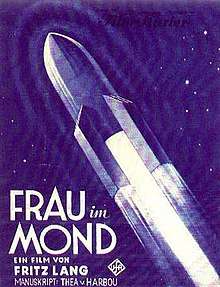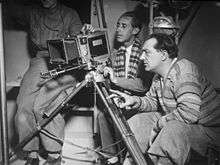Woman in the Moon
| Woman in the Moon | |
|---|---|
 Theatrical release poster | |
| Directed by | Fritz Lang |
| Screenplay by |
Fritz Lang Thea von Harbou |
| Based on | The Rocket to the Moon by Thea von Harbou |
| Starring |
Willy Fritsch Gerda Maurus Klaus Pohl Fritz Rasp Gustl Gstettenbaur Gustav von Wangenheim |
| Cinematography | Curt Courant |
| Distributed by | UFA |
Release date |
|
Running time | 156 min. / 200 min. (2000 restoration) / Spain:104 min. / Spain:162 min. (DVD edition) / USA:95 min / West Germany:91 min (edited version) (1970) |
| Country |
Germany (Weimar Republic) |
| Language |
Silent film German intertitles |
Woman in the Moon (German Frau im Mond) is a science fiction silent film that premiered 15 October 1929 at the UFA-Palast am Zoo cinema in Berlin to an audience of 2,000.[1] It is often considered to be one of the first "serious" science fiction films.[2] It was written and directed by Fritz Lang, based on the novel The Rocket to the Moon by his collaborator Thea von Harbou, his wife at the time. It was released in the USA as By Rocket to the Moon and in the UK as Woman in the Moon. The basics of rocket travel were presented to a mass audience for the first time by this film, including the use of a multi-stage rocket.[2] The film was shot between October 1928 and June 1929 at the UFA studios in Neubabelsberg near Berlin[1]

Plot
The film is a melodrama with scientific speculation. Helius (Willy Fritsch) is an entrepreneur with an interest in space travel. He seeks out Professor Mannfeldt (Klaus Pohl), a visionary who has written a treatise on the likelihood of finding gold on the moon, only to be ridiculed by his peers. Helius recognizes the value of Mannfeldt's work. However, a gang of evil businessmen, commanded by an American (Fritz Rasp), "The man who calls himself Walter Turner," as stated in the opening credits, have also taken an interest in Mannfeldt's theories.
Meanwhile, Helius's assistant Windegger (Gustav von Wangenheim) has announced his engagement to Helius's other assistant, Friede (Gerda Maurus). This is disconcerting to Helius, who secretly loves Friede, so he avoids their engagement party.
On his way home from his meeting with Professor Mannfeldt, Helius is mugged by henchmen of the gang of evil businessmen. They steal the research that Professor Mannfeldt had entrusted to Helius, and also burgle Helius's home, taking other valuable material. They then present him with an ultimatum: the gang know he is planning a voyage to the moon; either he includes them in the project, or they will sabotage it and destroy his rocket, which is also named Friede. Reluctantly, Helius agrees to their terms.
The rocket team is assembled: Helius; Professor Mannfeldt and his pet mouse (Josephine); Windegger; Friede; and Turner, representing the evil gang. After Friede blasts off, the team discovers that Gustav (Gustl Gstettenbaur), a young boy who has befriended Helius, is also aboard, as a stowaway, with his collection of science fiction pulp magazines.
During the journey, Windegger emerges as a coward, and the feelings of Helius toward Friede become known to her, creating a romantic triangle.
Once they get to the far side of the Moon, Mannfeldt and Turner prove Mannfeldt's theory that there is gold on the moon. They struggle in a cave, and Mannfeldt falls to his death in a crevasse. Turner attempts to hijack the rocket, and in the struggle, he is shot and killed. Gunfire damages the oxygen tanks, and they come to the grim realization that there is not enough oxygen for all to make the return trip. One person must remain on the moon. (In this film, the moon has a breathable atmosphere on its far side, per the theories of Peter Andreas Hansen, who is mentioned near the beginning of the film.)
Helius and Windegger draw straws to see who must stay and Windegger loses. Seeing Windegger's anguish, Helius decides to drug Windegger and Friede with a last drink together and take Windegger's place, letting Windegger return to Earth with Friede. Friede senses that something is in the wine. She pretends to drink and then retires to the compartment where her cot is located, closes and locks the door. Windegger drinks the wine, becoming sedated. Helius makes Gustav his confidant and the new pilot for the ship. Helius counts down the time for the ship's liftoff from a distance away. He watches it depart and a stricken look crosses his face as he realizes that he is alone on the moon. As he lowers his head and resignedly starts to move towards the survival camp originally prepared for Windegger, Helius discovers that Friede has decided to stay with him on the moon. He throws his arms wide like a child seeking to be held and Friede runs to him. They embrace and Helius weeps into her shoulder while Friede strokes his hair and whispers words of comfort to him.
Influence
Lang, who also made Metropolis, had a personal interest in science fiction. When returning to Germany in the late 1950s he sold his extensive collection of Astounding Science Fiction, Weird Tales, and Galaxy magazines.[3] Several prescient technical/operational features are presented during the film's 1920's launch sequence, which subsqequently came into common operational use during America's postwar space race:
- the rocket ship Friede is fully built in a tall building and moved to the launch pad
- as launch approaches, the launch team counts down the seconds from ten to zero ("now" was used for zero), and Woman in the Moon is often cited as the first occurrence of the "countdown to zero" before a rocket launch[2][4]
- the rocket ship blasts off from a pool of water; water is commonly used today on launch pads to absorb and dissipate the extreme heat and to damp the noise generated by the rocket exhaust
- in space, the rocket ejects its first stage and fires its second stage rocket, predicting the development of modern multistage orbital rockets
- the crew recline on horizontal beds to cope with the G-forces experienced during lift-off and pre-orbital acceleration
- floor foot straps are used to restrain the crew during zero gravity (Velcro is used today).
These items and the overall design of the rocket led to the film being banned in Germany from 1933-1945[5] during World War II by the Nazis, due to similarities to their secret V-2 project.
Rocket scientist Hermann Oberth worked as an advisor on this movie. He had originally intended to build a working rocket for use in the film, but time and technology prevented this from happening. The film was popular among the rocket scientists in Wernher von Braun's circle at the Verein für Raumschiffahrt (VfR). The first successfully launched V-2 rocket at the rocket-development facility in Peenemünde had the Frau im Mond logo painted on its base.[6] Noted post-war science writer Willy Ley also served as a consultant on the film. Thomas Pynchon's Gravity's Rainbow, which deals with the V-2 rockets, refers to the movie, along with several other classic German silent films.
Cast
- Klaus Pohl as Professor Georg Manfeldt
- Willy Fritsch as Wolf Helius
- Gustav von Wangenheim as Ingenieur Hans Windegger (as Gustav v. Wangenheim)
- Gerda Maurus as Stud. astr. Friede Velten
- Gustl Gstettenbaur as Gustav (as Gustl Stark-Gstettenbaur)
- Fritz Rasp as Der Mann "who calls himself Walter Turner"
- Tilla Durieux as Fünf Gehirne und Scheckbücher
- Hermann Vallentin as Fünf Gehirne und Scheckbücher
- Max Zilzer as Fünf Gehirne und Scheckbücher
- Mahmud Terja Bey as Fünf Gehirne und Scheckbücher
- Borwin Walth as Fünf Gehirne und Scheckbücher
- Karl Platen as Der Mann am Mikrophon
- Margarete Kupfer as Frau Hippolt, Haushälterin bei Helius
- Alexa von Porembsky as Eine Veilchenverkäuferin (as Alexa v. Porembska)
- Gerhard Dammann as Der Werkmeister der Helius-Flugwerften (as Dammann)
- Heinrich Gotho as Der Mieter vom II. Stock (as Gotho)
- Alfred Loretto as Zwei eindeutige Existenzen (as Loretto)
- Max Maximilian as Grotjan, Chauffeur bei Helius (as Maximilian)
- Edgar Pauly as Zwei eindeutige Existenzen (as Pauly)
- Die Maus Josephine as Maus
Further reading
- Kraszna-Krausz, A. (2004). "Frau in Mond (The Woman in the Moon)". In Rickman, Gregg. The Science Fiction Film Reader. Limelight Editions. pp. 20–21. ISBN 0879109947.
See also
References
- 1 2 Close-up on the photo album of Woman in the Moon by Fritz Lang
- 1 2 3 Weide, Robert (Summer 2012). "The Outer Limits". DGA Quarterly. Los Angeles, California: Director Guild of America, Inc.: 64–71. OCLC 68905662. A gallery of behind-the-scenes shots of movies featuring space travel or aliens. Page 68, photo caption: "Directed by Fritz Lang (third from right), the silent film "Woman in the Moon" (1929) is considered one of the first serious science fiction films and invented the countdown before the launch of a rocket. Many of the basics of space travel were presented to a mass audience for the first time."
- ↑ Gold, H. L. (December 1959). "Of All Things". Galaxy. p. 6. Retrieved 15 June 2014.
- ↑ "Spektrum der Wissenschaft" - DenkMal-Frage: "Was verdankt die Raumfahrt dem Stummfilm "Die Frau im Mond" (1929) von Fritz Lang?" http://www.wissenschaft-online.de/artikel/636420
- ↑ "Woman in the Moon (1929)". IMDb. Retrieved 2017-06-23.
- ↑ Hardesty, Von and Gene Eisman. Epic Rivalry: The Inside Story of the Soviet and American Space Race. Washington, D.C.: National Geographic, 2007. p. 2. ISBN 978-1-4262-0119-6.